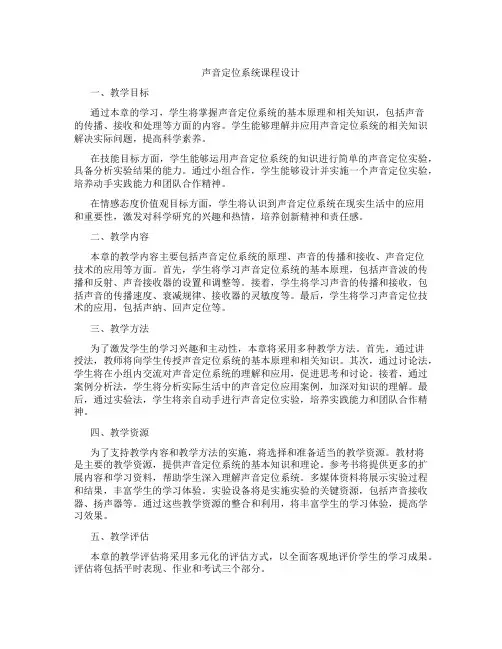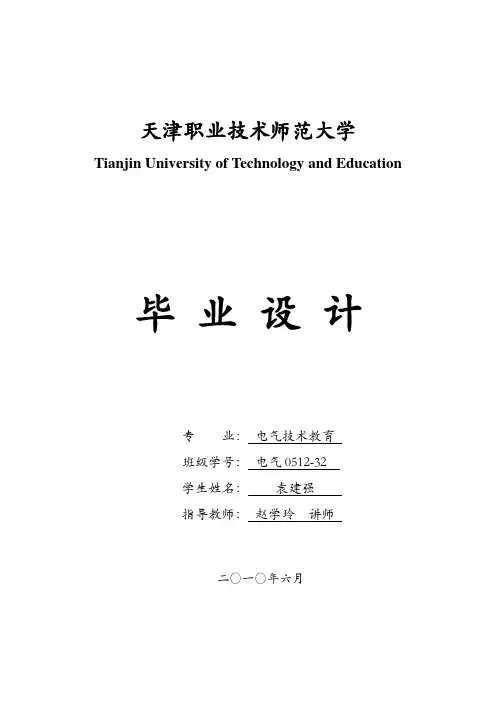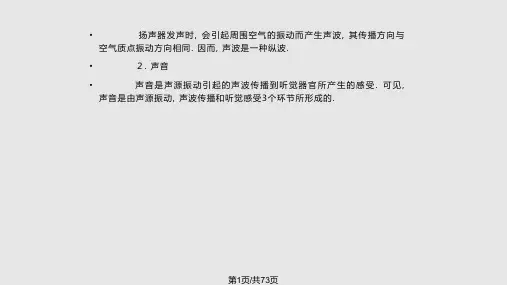声音定位系统演示PPT
- 格式:pptx
- 大小:865.03 KB
- 文档页数:17





声音定位系统课程设计一、教学目标通过本章的学习,学生将掌握声音定位系统的基本原理和相关知识,包括声音的传播、接收和处理等方面的内容。
学生能够理解并应用声音定位系统的相关知识解决实际问题,提高科学素养。
在技能目标方面,学生能够运用声音定位系统的知识进行简单的声音定位实验,具备分析实验结果的能力。
通过小组合作,学生能够设计并实施一个声音定位实验,培养动手实践能力和团队合作精神。
在情感态度价值观目标方面,学生将认识到声音定位系统在现实生活中的应用和重要性,激发对科学研究的兴趣和热情,培养创新精神和责任感。
二、教学内容本章的教学内容主要包括声音定位系统的原理、声音的传播和接收、声音定位技术的应用等方面。
首先,学生将学习声音定位系统的基本原理,包括声音波的传播和反射、声音接收器的设置和调整等。
接着,学生将学习声音的传播和接收,包括声音的传播速度、衰减规律、接收器的灵敏度等。
最后,学生将学习声音定位技术的应用,包括声纳、回声定位等。
三、教学方法为了激发学生的学习兴趣和主动性,本章将采用多种教学方法。
首先,通过讲授法,教师将向学生传授声音定位系统的基本原理和相关知识。
其次,通过讨论法,学生将在小组内交流对声音定位系统的理解和应用,促进思考和讨论。
接着,通过案例分析法,学生将分析实际生活中的声音定位应用案例,加深对知识的理解。
最后,通过实验法,学生将亲自动手进行声音定位实验,培养实践能力和团队合作精神。
四、教学资源为了支持教学内容和教学方法的实施,将选择和准备适当的教学资源。
教材将是主要的教学资源,提供声音定位系统的基本知识和理论。
参考书将提供更多的扩展内容和学习资料,帮助学生深入理解声音定位系统。
多媒体资料将展示实验过程和结果,丰富学生的学习体验。
实验设备将是实施实验的关键资源,包括声音接收器、扬声器等。
通过这些教学资源的整合和利用,将丰富学生的学习体验,提高学习效果。
五、教学评估本章的教学评估将采用多元化的评估方式,以全面客观地评价学生的学习成果。


I声音定位系统设计摘要从GPS到手机定位,定位系统在我们的日常生活中越来越重要。
声音定位,即确定声源(待测目标)在空间中的位置,其在地质勘探、人员搜救、目标跟踪等方面有着广泛的应用。
现在已将声音定位应用在可视电话、视频会议等系统中。
本系统由两部分组成。
声源模块是用单片机产生一个音频信号,该信号用三极管进行放大后输入到扬声器作为声源;接收模块使用麦克风进行接收,然后对接收的信号经过放大,接着经过带通滤波,去除周围环境的噪声,滤波后的信号正好是扬声器发出的声音信号。
声源定位是通过对四个拾音器接收到信号的时间先后进行处理,经过一套比较完善的算法可得声源的坐标,即可进行声源定位,最后将声源的具体坐标显示在液晶屏上。
设计完成后,进行了整体测试,基本能够达到设计要求。
关键词:定位,时间差,滤波,设计II Design of Sound Positioning SystemABSTRACTFrom the GPS to the phone positioning, positioning system in our daily life plays an increasingly important role. Sound localization, that determines sound source (test target) position in space, and its geological exploration, search and rescue personnel, target tracking, and so has a wide range of applications. Now sound positioning has been applying in video telephony, video conferencing systems.This system is to use MCU produce a audio signal, which is amplified by the transistor input to the speaker as the sound source. Receiving section for receiving the microphone, the first of the received signal after amplification and then through a band-pass filter, remove ambient noise, the filtered signal just beep emitted sound signal. Sound source localization is achieved by the four pickups have received the signal processing time, through a more perfect sound source algorithm can be obtained coordinates to the sound source localization. Finally, the sound source the specific coordinates displayed on the LCD screen.After the completion of the design, has carried on the overall test, basic can meet the requirements.KEY WORDS: positioning, time gap, filtering, designIII目录摘要 (I)ABSTRACT (II)1 绪论 (1)1.1 课题研究背景及意义 (1)1.2 国内外研究现状 (1)1.3 设计任务 (2)2 定位分类及原理 (4)2.1 定位系统的概述 (4)2.2 常用定位技术介绍 (5)2.2.1 GPS定位系统 (5)2.2.2 TDOA技术 (5)2.2.3 时差定位技术的优势 (9)2.3 本章小结 (9)3 总体设计方案 (10)3.1 系统方案论证 (10)3.1.1 信源模块 (10)3.1.2 声音接收模块 (10)3.1.3 滤波模块 (11)3.1.4 信号处理模块 (11)3.1.5 数据显示模块 (11)3.2 系统总体设计 (11)3.3 本章小结 (12)4 硬件设计 (13)4.1 声响模块电路的设计 (13)4.2 声音接收放大电路设计 (13)4.2.1 LM358芯片资料 (13)4.2.2 信号接收与放大电路 (14)4.3 选频电路设计 (14)4.3.1 LM567选频电路资料 (14)4.3.2 选频电路 (15)4.4 显示电路设计 (16)4.4.1 1602 (16)4.4.2 显示电路 (17)IV4.5 本章小结 (18)5 软件设计 (19)5.1 声源模块软件设计 (19)5.1.1 声源模块软件流程图 (19)5.1.2 声源模块参数计算 (19)5.2 数据处理及控制显示 (21)5.2.1 1602的指令说明及时序 (21)5.2.2 数据获得与处理的原理 (23)5.2.3 软件流程图 (24)6 总结与展望 (26)6.1 设计总结 (26)6.2 设计展望 (26)致谢 ........................................................................................................ 错误!未定义书签。

天津职业技术师范大学Tianjin University of Technology and Education毕业设计专业:电气技术教育班级学号:电气0512-32学生姓名:袁建强指导教师:赵学玲讲师二〇一〇年六月天津职业技术师范大学本科生毕业设计平面区域声音定位引导系统设计Localization Guidance System Design for Soundin plane Domain专业班级:电气0512班学生姓名:袁建强指导教师:赵学玲讲师学院:自动化与电气工程学院2010年6月摘要声音引导系统,是基于无线通信技术的新型导引系统,可以应用在新型智能机器人控制系统,这种声音控制机器人的运动方式将有着广阔的应用前景。
声音引导(声音定位),在现实生活中有着重要意义。
例如,在救援抢险中,可以利用声音传感器接受某一特定幅度或者频率的声音,通过对声音源的分析处理来获知其地理位置,配合GSP 卫星定位技术来搜救目标源。
本设计的声音引导系统可实现对一定范围内的可移动声源进行定位和引导其移向预定区域。
该系统用蜂鸣器作为可移动声源固定在小车上,三个声音接收装置固定在地面上,通过计算声源信号到达两个接收器的时间差来确定声源位置,并引导其向指定位置运动。
声音接收单元与可移动声源之间通过无线传输方式实现数据的传输,来实现可移动声源运动状态的控制。
其运动状态有前进、后退、左转、右转、停止等。
系统硬件部分主要包括两个AVR mega16单片机控制单元、电机驱动单元、无线传输单元、声音发射和接收单元以及电源电路构成。
软件部分主要是音频信号的产生和接收、数据处理和无线传输以及对可移动声源的控制。
该系统电路简单、功能完善、功耗低、性价比高。
关键词:单片机; 声音定位; 无线传输ABSTRACTSound guide system is the system which based on wireless communication technique,which can be used in new kind of intelligent robot control system,this robot controlled by voice will have a wide application foreground.sound guide (sound location) has a improtant influence on real life.For example,in a rush to deal with an emergency,people can use sound sensor to receive the specific width and frequency of theparticularvoice, then analy the source of sound to get other geographical position,and coordinate with GPRS technique to search and save the objective.The sound guidance system designing that originally may realize the allocation being in progress to the move acoustic source within certain range and guide the person to move to predetermined area. Be system's turn to use buzzer phone to fix on the handcart as move acoustic source, three sound receiving system fixes on the floor, the time by the fact that the signal calculating an acoustic source gets to two receivers dispatches coming to ascertain acoustic source location, and guide the person to move to assigned address. Transmission shutting out the voice of the data receiving an element and passing wireless transmission way realization between move acoustic source, come to realize move acoustic source motion state controlling. It's motion state has going ahead , retreating , turning left , turning right , stopping and so on.The system mainly consists of two parts, hardware design and software design. Hardware design are composed of two A VR mega16 microcontroller control module, motor drive circuits, the wireless transmission module, the sound transmitting and receiving circuit and power circuit. Software’s design mainly aim to the the sound’s production,receiving and processing and to the motor control. The system’s most important feature is the software system with hierarchical、modular design methods,which makes complex mathematical models and control algorithms to simplify and can get rapid development. The whole system is simple, functional, and low power consumption, cost-effective, significantly reducing system power consumption.The key words: MCU; sound localization; wireless transmission目录1 引言 (1)1.1 课题背景 (1)1.2 主要内容 (2)2 系统方案设计 (3)2.1 功能描述 (3)2.2 方案论证 (3)2.2.1 主机单元 (4)2.2.2 从机单元 (5)3 系统整体设计 (7)3.1 硬件设计 (7)3.1.1 主机设计 (7)3.1.2 从机设计 (9)3.2 软件设计 (16)3.2.1 主机设计 (16)3.2.2 从机设计 (20)4 测试数据及分析 (21)4.1 测试仪器 (21)4.2 测试环境及方法 (21)4.3 测试数据及分析 (21)总结 (22)参考文献 (23)附录1 程序 (24)附录2 实物图 (32)致谢 (33)1 引言1.1 课题背景目前,由于人工智能、计算机科学、传感器技术及其它相关学科的长足进步,使得机器人的研究在高水平上进行,同时也为机器人控制系统的性能提出更高的要求。


